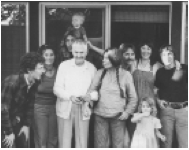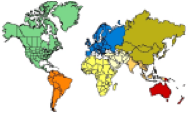Immersion Students Finding Their Voice
The ACIE Newsletter, November 2009, Vol. 13, No. 1
By Maureen Curran-Dorsano, Teacher, Normandale French Immersion School, Edina, MN
Today’s students are experiencing the worldwide web in new and powerful ways, thanks to a set of applications commonly referred to as Web 2.0 tools. These tools are often associated with terms like social-networking, collaboration, two-way communication, global exchange, student-created and real-world application, words that might well be used to describe the goals of immersion education. Indeed, Web 2.0 tools offer our students the opportunity to use their language in ways never before possible, with tasks that are interpersonal and intercultural, engaging and authentic. What more could an immersion teacher ask for?
One online tool that is especially effective and easy to use is VoiceThread (www.voicethread.com). VoiceThread allows conversations to take place around visual and audio media, created by either the teacher or the students themselves. Users upload images and then add their own voice recording to narrate, describe or discuss what they see onscreen. They can annotate their images by “doodling,” that is, underlining, circling, numbering, and so on. Visitors to the site can also add comments by phone, microphone, webcam, text or by uploading a document, making this a valuable tool for collaboration within the classroom or between two or more classrooms. All of this is free of charge, though there are some premium features available for a subscription fee.
Table 1: Three Different Ways to Use VoiceThread
 | Voici Sylvie. This is a teacher-made VoiceThread, narrated by a native French speaker, providing an excellent language model for young listeners. K-1 students can listen to the description of Sylvie’s face, and repeat after the teacher, who has used the doodling tool to highlight each vocabulary word. Older students could also use this as a dictation exercise. |  |
La familia Rivera. This Spanish VoiceThread is a great example of a collaborative project that likely was created in a Spanish foreign language class. The native-speaking “mother” (likely the classroom teacher) describes each person in the photo, then each “family member” – (classroom learners of Spanish) adds a comment, clearly reading off of scripts they have prepared. This serves as a good model for the collaborative potential of VoiceThread. |
 |
Classroom 2.0 is actually an English VoiceThread but shows off the intercultural opportunities possible with this tool. People from around the world introduce themselves, circle their country on the map and offer a comment about the VoiceThread. A project rich in potential for an immersion classroom. |
When you go to the VoiceThread site, you should begin by simply browsing. There are hundreds of VoiceThreads to look at, a great many of them educational in purpose, and they will get your creative juices flowing. Then narrow your browsing to your immersion language. Some of these VoiceThreads could be used as part of a lesson as they are or as a model for your own VoiceThread. Table 1 on page 9 displays three VoiceThreads that each use the online application in a different way. Simply type in the title in the Browse window when you visit the online site.
I have used VoiceThread as an extension of a “response to reading” writing project (Des personnages principaux). Students illustrated the main character of their book, wrote a descriptive paragraph about the character, then made a recording of their description. The kids loved having their work published on the Internet and parents appreciated the chance to hear their child speak French. This year my goal is to involve a partner class making the online experience even more meaningful.
VoiceThread offers limitless intercultural possibilities to our students. It opens a window into our classrooms for parents who might never hear their children speak the immersion language. It motivates our students to use their immersion language and helps teachers analyze and evaluate their students’ oral language skills. In short, it is a tool that every immersion teacher should make part of his or her toolbox.
A sample of other techno tips in the acie archives
www.carla.umn.edu/immersion/acie/#tech
Top Ten Techno Tips For Immersion Teachers from the ACIE Archives (May 2007)
Using Keypals with Post-Secondary Immersion Students (May 2006)
Immersion Learning, Unplugged (November 2004)
Creating Independent Learners of Japanese via the Internet (May 2004)
Sleepless in Maryland: Sleep Deprived Teacher Surfs Web for French Gold (November 2003)
